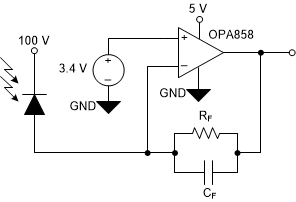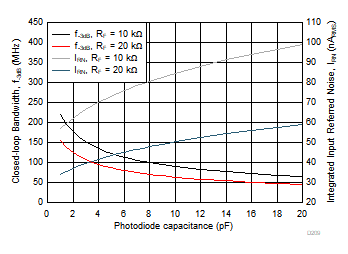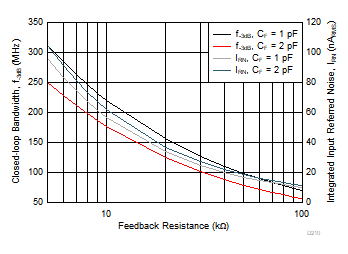ZHCSMN4 February 2021 OPA858-Q1
PRODUCTION DATA
- 1 特性
- 2 应用
- 3 说明
- 4 Revision History
- 5 Pin Configuration and Functions
- 6 Specifications
- 7 Parameter Measurement Information
- 8 Detailed Description
- 9 Application and Implementation
- 10Power Supply Recommendations
- 11Layout
- 12Device and Documentation Support
- 13Mechanical, Packaging, and Orderable Information
9.1.1 Using the OPA858-Q1 as a Transimpedance Amplifier
The OPA858-Q1 design has been optimized to meet the industry's growing demand for wideband, low-noise photodiode amplifiers. The closed-loop bandwidth of a transimpedance amplifier is a function of the following:
- The total input capacitance. This includes the photodiode capacitance, input capacitance of the amplifier (common-mode and differential capacitance) and any stray capacitance from the PCB.
- The op amp gain bandwidth product (GBWP), and,
- The transimpedance gain RF.
 Figure 9-1 Transimpedance Amplifier Circuit
Figure 9-1 Transimpedance Amplifier CircuitFigure 9-1 shows the OPA858-Q1 configured as a TIA with the avalanche photodiode (APD) reverse biased such that the APD cathode is tied to a large positive bias voltage. In this configuration the APD sources current into the op amp feedback loop so that the output swings in a negative direction relative to the input common-mode voltage. To maximize the output swing in the negative direction, the OPA858-Q1 common-mode is set close to the positive limit, 1.6 V from the positive supply rail.
The feedback resistance RF and the input capacitance form a zero in the noise gain that results in instability if left unchecked. To counteract the effect of the zero, a pole is inserted by adding the feedback capacitor (CF.) into the noise gain transfer function. The Transimpedance Considerations for High-Speed Amplifiers application report discusses theories and equations that show how to compensate a transimpedance amplifier for a particular gain and input capacitance. The bandwidth and compensation equations from the application report are available in a Microsoft Excel ® calculator. What You Need To Know About Transimpedance Amplifiers – Part 1 provides a link to the calculator.
 Figure 9-2 Bandwidth and Noise Performance vs Photodiode Capacitance
Figure 9-2 Bandwidth and Noise Performance vs Photodiode Capacitance Figure 9-3 Bandwidth and Noise Performance vs Feedback Resistance
Figure 9-3 Bandwidth and Noise Performance vs Feedback ResistanceThe equations and calculators in the application report and blog posts referenced above are used to model the bandwidth (f-3dB) and noise (IRN) performance of the OPA858-Q1 configured as a TIA. The resultant performance is shown in Figure 9-2 and Figure 9-3. The left side Y-axis shows the closed-loop bandwidth performance, while the right side of the graph shows the integrated input referred noise. The noise bandwidth to calculate IRN, for a fixed RF and CPD is set equal to the f–3dB frequency.
Figure 9-2 shows the amplifier performance as a function of photodiode capacitance (CPD) for RF = 10 kΩ and 20 kΩ. Increasing CPD decreases the closed-loop bandwidth. It is vital to reduce any stray parasitic capacitance from the PCB to maximize bandwidth. The OPA858-Q1 is designed with 0.8 pF of total input capacitance to minimize the effect on system performance.
Figure 9-3 shows the amplifier performance as a function of RF for CPD = 1 pF and 2 pF. Increasing RF results in lower bandwidth. To maximize the signal-to-noise ratio (SNR) in an optical front-end system, maximize the gain in the TIA stage. Increasing RF by a factor of X increases the signal level by X, but only increases the resistor noise contribution by √ X, thereby improving SNR.